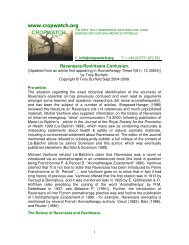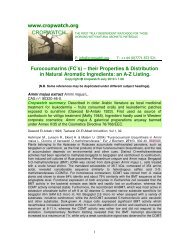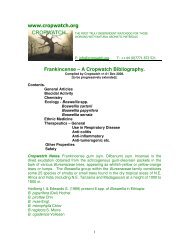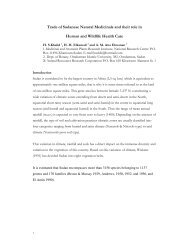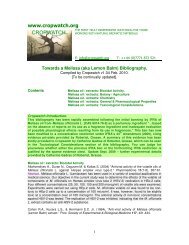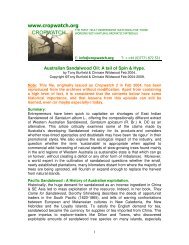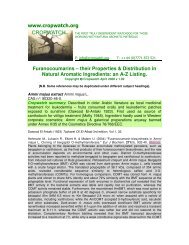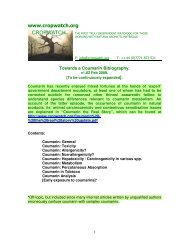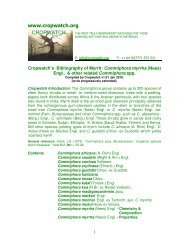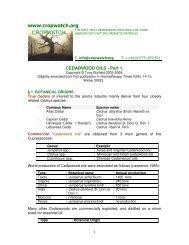Sandalwood Biblio - Cropwatch
Sandalwood Biblio - Cropwatch
Sandalwood Biblio - Cropwatch
Create successful ePaper yourself
Turn your PDF publications into a flip-book with our unique Google optimized e-Paper software.
Brunke E.J. & Tumbrink L. (1986) "First total synthesis of spirosantalol." Progress in Essential Oil<br />
Research pp321-327.<br />
Brunke E.-J. Hammerschmidt F.-J. & Struwe H. (1980) "(+)-epi-Santalol isolierung aus<br />
sandelholzol und partialsynthese aus (+) -alpha-santalol. Tetrahedron Lett. (1980) 2405.<br />
Brunke E.-J. & Klein E. (1982) "Chemistry of sandalwood fragrance" In Fragrance Chemistry. The<br />
Science of Smell, Academic Press NY p397.<br />
Buchbauer G., Stappen I., Pretterklieber C & Wolschann P. (2004) “Structure–activity<br />
relationships of sandalwood odorants: synthesis and odor of tricyclo β-santalol” Eur J Med Chem<br />
39(12), 1039-1046. Abstract: In a series of structure–odor relationship investigations the<br />
synthesis of a new tricyclic β-santalol derivative is described. The product of a multi-step<br />
synthesis appears in an olfactive evaluation more or less odorless may be slightly creamy but<br />
definitely with no sandalwood odor. This modification with a bulky aliphatic bridge in the<br />
neighbourhood of the quaternary C3-atom demonstrated the sensitivity of sandalwood odor on<br />
the structure of β-santalol analogues.<br />
Buchbauer G., Winiwarter S. & Wolschann P. (1992) "Surface comparisons of some odour<br />
molecules: conformational calculations on sandalwood odour V.” J. Comput. Aided Mol. Des.<br />
6(6), 583-592. Abstract: Molecular surface comparison seems to be a very suitable tool for the<br />
investigation of small differences between biologically active and inactive compounds of the same<br />
structural type. A fast method for such comparisons, based on volume matching followed by the<br />
estimation of comparable surface dots, is presented and applied on a few selected sandalwood<br />
odour molecules.<br />
Demole E., Demole C. & Enggist P. (1976) “A chemical investigation of volatile constituents of<br />
volatile constituents of East Indian sandalwood oil (Santalum album L.)” Helv. Chim. Acta 59,<br />
737. Abstract. Distillation foreruns from East Indian sandalwood oil (Santalum album L.),<br />
representing 5-8% of the oil, have been investigated using fractional distillation, preparative<br />
column chromatography, gas liquid chromatography (GLC.), and chemical treatments. This<br />
allowed the isolation and characterization by their spectral data of 46 compounds. 32 of them<br />
were newly identified sandalwood oil constituents including 4 novel substances: santalone (2), 4-<br />
methylcyclohexa-1,3-dien-1-yl methyl ketone (4), 5,6-dimethyl-5-norbornen-exo-2-ol (7), and (E)-<br />
5-(2,3-dimethyl-3-nortricyclyl)-pent-3-en-2-one (20). The other constituents identified were 1-<br />
furfuryl-pyrrole (10) and 10 phenols accompanied by 17 terpene and sesquiterpene derivatives.<br />
Endo-2,endo-3-dimethyl-norbornan-exo-2-ol (6), an -santenol (z), precursor, was present in the<br />
last group of constituents. The compounds 2, 4, 6, 7, 20 have been synthesized as well as<br />
another novel constituent, endo-2-mythyl-3-methylidene-norbornan-exo-2-ol (5).<br />
Dimoglo A.S., Beda A.A., Shvets N.M., Gorbachov M.Yu., Kheifits L.A. & Aulchenko S. (1995)<br />
"Investigation of the relationship between sandalwood odour & chemical structure: electron<br />
topological approach.” New J of Chemistry 19(2), 149-154.<br />
Hatt H.H. & Schoenfeld R. (1956) “Some seed fats of the Santalaceae family.” J. Sci Food Agric<br />
7(2), 130-133. <strong>Cropwatch</strong> comments. The drying oil from the hard-shelled seeds (50-60% fixed<br />
oil) contains 30-35% santalbic acid and 1% stearolic acid. Tthese acetylenic compounds inhibit<br />
lipoenzymes in experimental animals.<br />
CH 3<br />
(CH 2<br />
) 5<br />
CH C<br />
H<br />
(CH 2<br />
) 7<br />
COOH<br />
santalbic acid<br />
Hayashi K., Haseegawa T., Machiguchi T. & Yoshida T. (2005) “"Isolation and structure of a new<br />
aroma constituent from Indian <strong>Sandalwood</strong>, Santalum album L." Nippon Kagakkai Koen Yokoshu<br />
85(2), 863. Abstract. This work presents the isolation and structural elucidation of a new aroma<br />
compound in the major component from Indian sandalwood tree, Santalum album L., not from<br />
sandalwood oil obtained through steam distillation. We have found that the compound has a<br />
34





